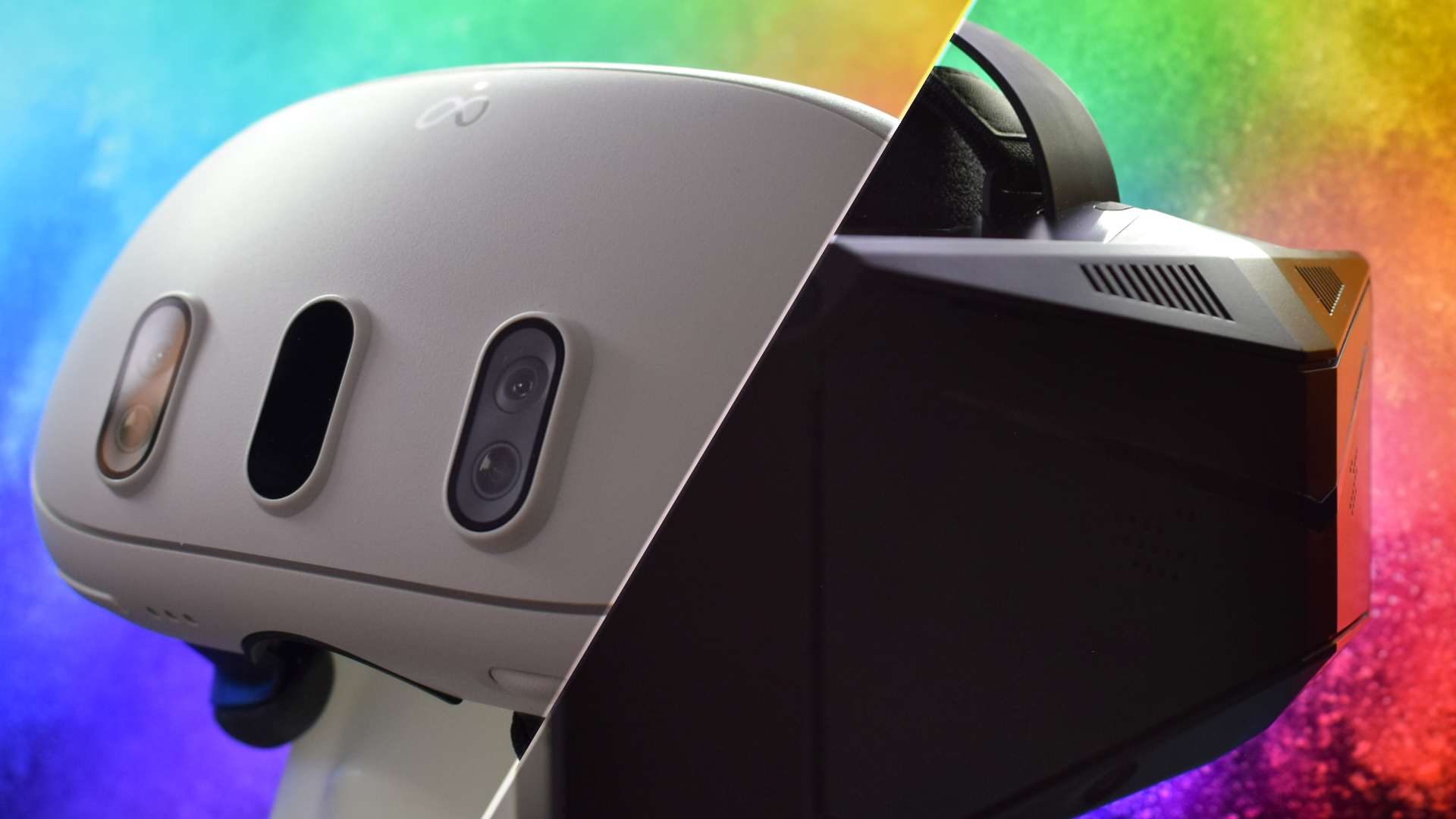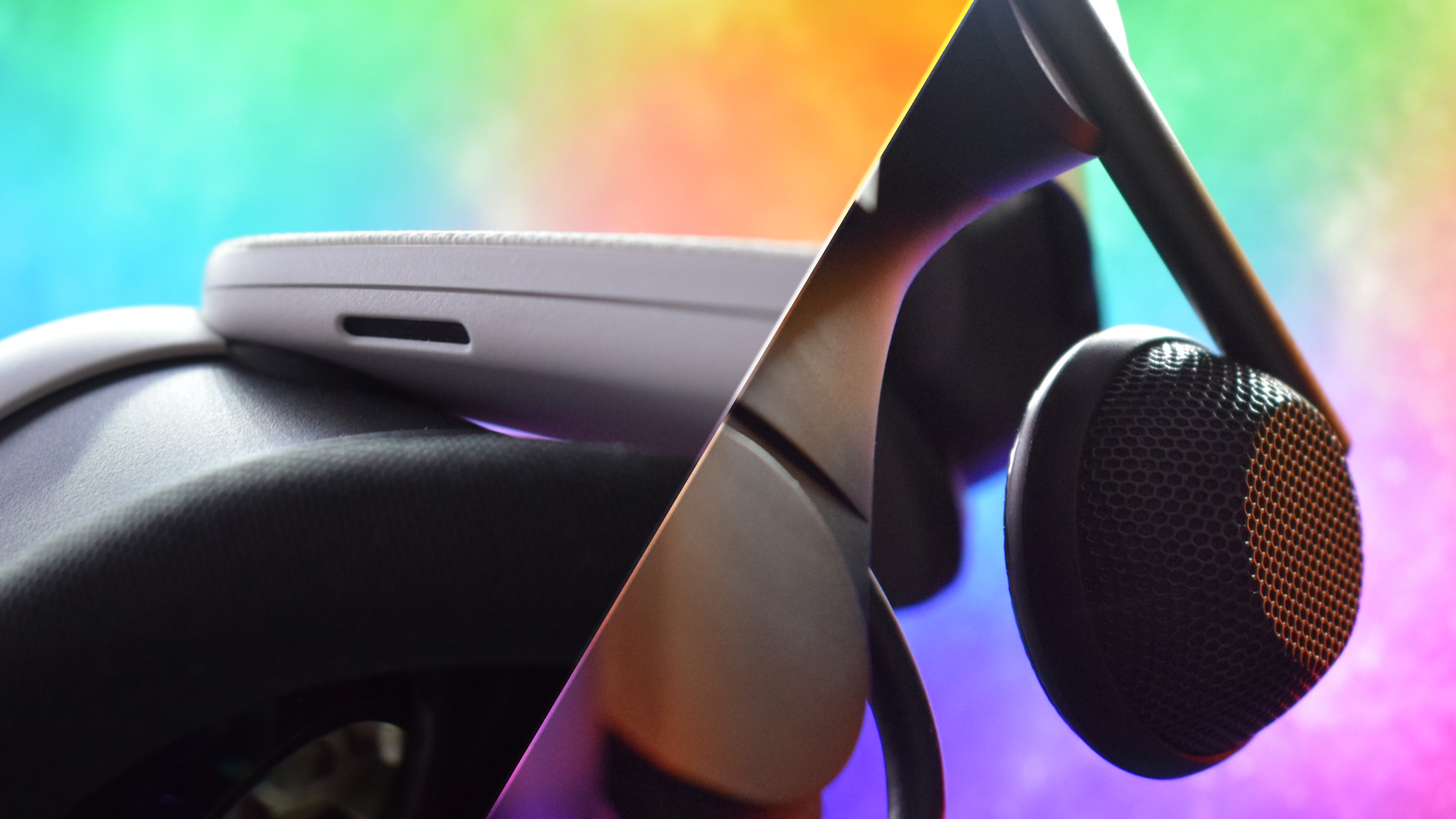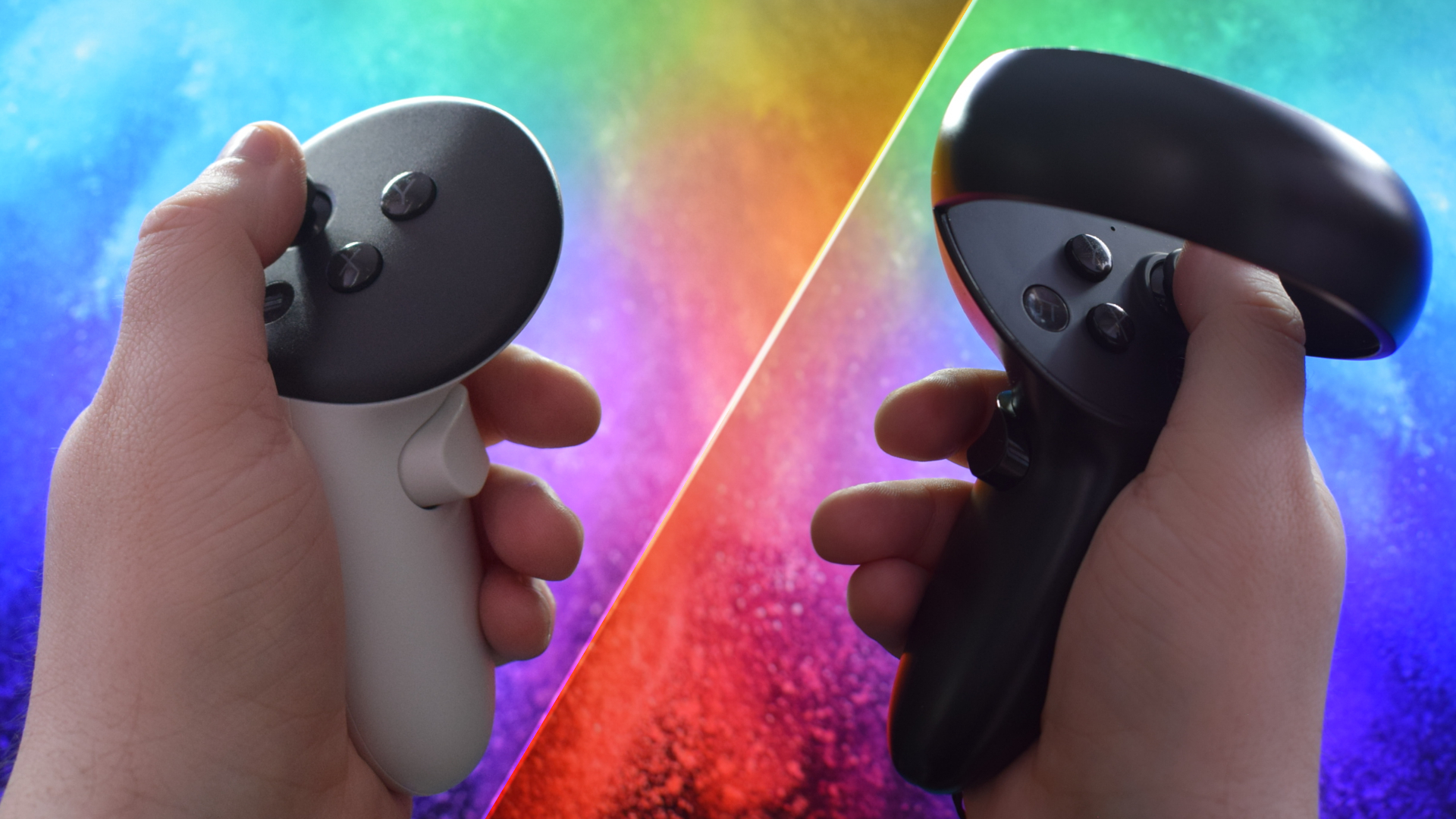Meta Quest 3 vs. Pimax Crystal: For VR, is it better to buy bigger?
A solid all-arounder or the premium visual experience, which V headset is right for you?

In the world of VR, there are two types of headset: those for the everyfolk who want a slice of standalone gaming and some PCVR action, and the headsets for enthusiasts — those who want the kind of VR experience that pushes immersion to all-new heights.
There are two stand-out options to place head-to-head in that sense and see who comes out on top. First, the Meta Quest 3, an accessible all-around headset good for a little bit of everything and backed by a legacy of VR excellence.
Second, the Pimax Crystal, a VR headset that boasts the kind of crisp clarity that will leave you believing the lenses of your headset are portholes to a “What if..?” alternate dimension where you’re the lead character.
Enthusiast headsets often have plenty to brag about over performance and visuals, but do they hold up well enough to fend off Meta’s third-generation headset and all of its bells and whistles? Let’s find out.
Meta Quest 3 vs. Pimax Crystal: Specs
| Header Cell - Column 0 | Meta Quest 3 | Pimax Crystal |
|---|---|---|
| Price | $499, $649 | $1,599 |
| Platform | Horizon OS, SteamVR | Pimax Store, SteamVR |
| Processor | Qualcomm Snapdragon XR2 Gen 2 | Qualcomm Snapdragon XR2 |
| RAM | 8GB | 8GB |
| Storage | 126GB/512GB | 256GB |
| Optics | Pancake lenses (Plastic) | Aspheric glass lenses |
| Display | LCD (2064x2208 pr-eye), 120Hz | QLED (2880x2880 per-eye), 120Hz |
| FoV | H:110°/V:96°, 18 PPD | H:115°/V:105°, 35 PPD |
| IPD | 58-71mm | 58-72mm |
| Tracking | 6 DoF, Inside-out | 6 DoF, Inside-out |
| Controllers | 2 x Touch Plus Controller (6 DoF, AA batteries) | 2 x Pimax Reality Controller (6 DoF, rechargeable) |
| Weight | 1.13 pounds | 1.86 pounds |
Meta Quest 3 vs. Pimax Crystal: Price and availability
The Meta Quest 3, released October 2023, is available in two configurations: a 128GB model for $499 and a 512GB model for $649. Both models feature the same headset and battery-powered Touch Plus controller combo. The Quest 3 includes a charger and a USB Type-C cable.
The Quest 3 is good to go right out of the box, requiring about as much setup as placing it on your head.
Meta also offers a ‘Play Now, Pay Later’ scheme that spreads the cost (over 24 months) of the Quest 3 headset along with 24-month subscriptions to the Meta Quest+ digital game library, Meta Warranty Plus that starts at $24.99 per month for the 128GB model or $34.99 for the 512GB model.
The Pimax Crystal, released May 2023, is available in a single 256GB configuration for $1,599. The headset comes with two rechargeable controllers, a battery charging dock with two rechargeable headset batteries, two USB Type-A to Type-C cables, and a DisplayPort to USB Type-A/DisplayPort cable (16 feet).
Stay in the know with Laptop Mag
Get our in-depth reviews, helpful tips, great deals, and the biggest news stories delivered to your inbox.
While the Quest 3 doesn’t offer as much right out of the box, the fact it delivers a comparable experience for a third of the price is undeniable value. While Pimax’s in-the-box offerings are more than welcome what you’re getting is a more complex device. The Quest 3 is good to go right out of the box, requiring about as much setup as placing it on your head.
Winner: Meta Quest 3
Meta Quest 3 vs. Pimax Crystal: Graphics and visuals
Visuals will often be the deciding factor for those seeking detailed, immersive results. Unshockingly, the more expensive headset, with its premium lenses and expanded resolution, takes home the prize. But it’s worth noting how and why.
The Pimax Crystal adopts glass lenses and a wide FoV (130 degrees diagonal, 115 degrees horizontal, and 105 degrees vertical) to great effect. The Quest 3 is no slouch on clarity, but the Pimax’s 35 PPD (Pixels Per Degree) practically doubles that of Meta’s 18 PPD lenses.
Paired with a sizable 2880p per-eye resolution, you get a tighter grouping of pixels that brings rich details with real clarity and focus to images that most other headsets can’t hope to match. You can fool yourself while wearing the Pimax Crystal into thinking that it’s not all that different from the Quest 3’s picture, but it's only when you switch back to Meta’s headset that you realize how striking the differences are.
In this image, taken from a gaming laptop running I Expect You To Die 2 through SteamVR, you can clearly see the difference in picture quality between the Crystal and the Quest 3.
This may be a slightly unfair to both headsets as we have to contend with image compression. For the record, both headsets appear a little sharper than these images would suggest, but the differences between the two are still apparent. Also worth noting, the images used for the Quest 3 screenshots have been scaled up in size to match that of the Pimax Crystal. As such, the Quest 3's in-headset picture is far more flattering.
That being said, looking at the Pimax Crystal's captures, objects in the distance of this screenshot are more discernable, the text is sharper, and the image is more crisp. From the Quest 3’s perspective, the image is stretched across its field of view, text is harder to read at a distance, and the image is overall muddier.
This time, using screenshots captured by each headset within Star Wars: Squadrons, both images appear to show a generous amount of details, but the Crystal’s higher resolution offers a more crisp render of hard edge surfaces.
In another side-by-side comparison (scaled to match resolution and cropped to 1920x1080 for ease of viewing), we can see the difference in FoV come into play and the sharper image quality of the Crystal. The characters in the distance appear much clearer, and there’s a wider image on show with the Crystal’s output.
It’s worth taking into account that the Crystal’s aspheric glass lenses help to retain as much of this crispness as possible while in the headset. Meanwhile, the Quest 3’s plastic pancake lenses work overtime to maintain as much clarity as possible but are limited in their potential by the headset’s lower-resolution LCD panels.
Winner: Pimax Crystal
Meta Quest 3 vs. Pimax Crystal: Audio

The Quest 3 offers open-ear speakers that Meta claims are up to 40% louder than the Quest 2 that came before it, capable of all-encompassing and immersive 3D audio soundscapes.
The sound quality is impressive, and the bass doesn't go to waste in the same way Meta’s headset allows it to.
Its speakers are well-positioned to deliver crisp audio with maximum effect, as its spatial audio does wonders for pinpointing sounds from various directions. However, the open-ear design allows the bass to fall off easily, and cupping a hand to your ear will quickly remind you of the full richness of the audio that goes to waste.
In contrast, the Pimax Crystal features adjustable off-ear headphones that directly channel the rich DMAS audio into the wearer’s ears. The sound quality is impressive, and the bass doesn't go to waste in the same way Meta’s headset allows it to. The level of immersion delivered is second to none, mainly thanks to DTS:X support for sonic landscapes.
Winner: Pimax Crystal
Meta Quest 3 vs. Pimax Crystal: Controllers

The Quest 3’s Touch Plus controllers improve on the Quest 2’s Touch peripherals in almost every way. They’re more streamlined, dropping the halo design while adopting TruTouch haptics that deliver a wider range of sensations and feedback to actions and elements happening on the virtual stage.
The Quest 3’s Touch Plus controllers are intensely accurate and feature much more sturdy triggers and switches
Another way to control your Quest 3 is through hand tracking, allowing you to do away with controllers entirely and navigate by plucking at the air in front of you.
Meta has done a fantastic job of accurately translating hand movements and gestures, allowing for a pleasant enough experience when navigating menus and using the headset for more entertainment-focused purposes. However, it lacks the accuracy to be a viable control method beyond this.
The controllers for the Pimax Crystal are eerily familiar, adopting the look, style, and button placement of the Quest 2’s Touch controllers almost exactly. That includes maintaining the iconic Oculus halo design. Compared with the Quest 3’s Touch Plus controllers, Pimax’s offering does seem somewhat dated.
However, its controllers are rechargeable via USB-C, and even though they only pack a 700mAh battery, they still manage to deliver considerable game time due to their lack of advanced haptics.
Still, while both are more than serviceable options, The Quest 3’s Touch Plus controllers are intensely accurate and feature much more sturdy triggers and switches alongside their immersion-deepening rumbles.
Winner: Meta Quest 3
Meta Quest 3 vs. Pimax Crystal: Experience
While you can break down the experience into individual components and give Pimax its flowers for the fantastic work it has done in visual and audio immersion, its highly specialized approach leaves it lacking in several key areas.
While both headsets offer stand-alone modes, only Meta’s is worth your time, attention, or money. Horizon OS is a gold standard (at least when it comes to what's available) for VR/AR operating systems. It is easy to navigate, effortless to become familiar with, and generally spry in responsiveness and overall performance.
The Meta Horizon Store (formerly the Oculus Store) is a vast library of content that caters to gamers of all genres and supplies apps for everything from health and fitness to productivity and smart home interactions. While its prices could be a little more lenient, this is the only stand-alone VR mode worth shouting about, and the amount of content from games to entertainment is unrivaled.
While Pimax's headset might have the edge on immersion through its high-res displays and bassy soundscapes, it’s the Quest 3 that delivers the best overall experience.
In comparison, Pimax’s stand-alone mode is a Temu knockoff of the Quest 2’s earliest days. It apes the style of Meta’s interface but lacks the flair and accessibility that comes with it. While there’s little more to say about the Pimax Store, that’s only because there’s genuinely little more to it.
Pimax’s stand-alone mode feels like the false front architecture of the Wild West, posing as something more grand than it is. Entering its storefront only cements this notion. In contrast to the Quest’s solid library of recognizable titles such as Assassin’s Creed Nexus VR, The Walking Dead: Saints and Sinners, Arizona Sunshine 2, Beat Saber, Resident Evil 4, and more, Pimax offers you all the best in indie game shovelware and very little else.
Once you factor in the Quest 3’s enhanced comfort, full-color passthrough, and impressive AR capabilities, pairing the two against one another seems almost unfair. While Pimax's headset might have the edge on immersion through its high-res displays and bassy soundscapes, it’s the Quest 3 that delivers the best overall experience. It offers more, gives access to more, and is more enjoyable to use across the board.
Winner: Meta Quest 3
Bottom line
While I can’t speak on behalf of everyone, as many who want to purchase a VR headset might see visuals as the be-all-end-all of the experience, it’s clear to me that the Quest 3 is the undeniable victor as an overall product.
If you’re a steadfast PCVR gamer with no want nor need for anything beyond a headset of the highest caliber, then maybe you’d disagree. However, given its ease of use, smaller frame, wider options for gaming, and impressive AR capabilities, you’re limiting yourself to only a tiny slice of the wider VR/AR pie.
While there’s an argument for enthusiasts to go with the more expensive option, especially if they’re simulation die-hards who believe HUDs are for babies, and reading the information directly off of in-game panels is the only way to go.
However, for most people, myself included, the Quest 3 raises the bar as a well-rounded device, and it’s hard to see another in this market capable of besting it.
More from Laptop Mag

Rael Hornby, potentially influenced by far too many LucasArts titles at an early age, once thought he’d grow up to be a mighty pirate. However, after several interventions with close friends and family members, you’re now much more likely to see his name attached to the bylines of tech articles. While not maintaining a double life as an aspiring writer by day and indie game dev by night, you’ll find him sat in a corner somewhere muttering to himself about microtransactions or hunting down promising indie games on Twitter.
